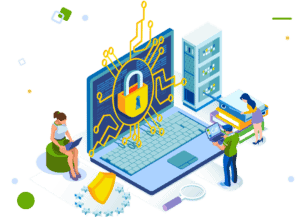Essential Tips for Ensuring Your IT Strategy Supports E-Commerce Goals

E-commerce has become a cornerstone of the global economy, with online sales steadily growing year after year. This shift highlights the need for businesses to adopt secure and efficient IT practices.
A robust IT strategy is crucial for e-commerce stores for several reasons:
- Alignment with Business Goals: A well-defined IT strategy helps align technological initiatives with overall business objectives, ensuring smoother operations and increased efficiency.
- Enhancing Customer Experience: Effective IT management facilitates better user experiences, from website navigation to secure transactions.
Security is paramount today. Implementing strong security measures protects customer data and maintains brand integrity. Key considerations include:
- Preventing breaches and fraud, which have cost the e-commerce industry billions.
- Building consumer trust through secure payment processing and data protection.
By prioritizing e-commerce security and IT strategies, businesses can drive success while safeguarding their reputation and customer relationships.
Understanding E-Commerce Security
E-commerce security includes the methods and technologies used to protect online transactions and customer information. This involves keeping data like credit card numbers, personal information, and login details safe from unauthorized access and cyber threats.
Why Strong Security Frameworks Matter
Strong security systems are important for a few reasons:
- Customer Trust: A strong security system builds trust with consumers. When customers feel safe, they are more likely to finish their purchases.
- Brand Reputation: One data breach can seriously harm an e-commerce brand’s reputation. It’s crucial to maintain high security standards for long-term success.
Common Security Threats to E-Commerce Stores
E-commerce stores face various security threats, including:
- Data Breaches: Unauthorized access to sensitive customer information can lead to significant financial loss and legal consequences.
- Phishing Attacks: Cybercriminals often use deceptive emails or websites to trick users into providing personal data.
- DDoS Attacks: Distributed Denial of Service attacks overwhelm a website with traffic, making it inaccessible to legitimate users.
It’s essential to implement effective e-commerce security practices to reduce these risks and protect both the business and its customers.
The Role of IT Strategy in E-Commerce
An effective IT strategy is crucial for aligning with business objectives and driving technology innovation. E-commerce businesses thrive when their IT framework supports their goals. Key aspects include:
1. Alignment with Business Goals
A well-defined IT strategy ensures that technology initiatives directly contribute to business success. This alignment fosters efficiency, enhances customer experiences, and promotes scalability.
2. Role of the CIO
The Chief Information Officer (CIO) plays a pivotal role in crafting IT strategies tailored for e-commerce. They assess technological needs, identify trends, and prioritize projects that can enhance operational efficiency and security, ultimately driving growth.
3. Communication and Governance
Strong communication channels within the organization promote transparency and collaboration among teams. Governance frameworks guide decision-making processes, ensuring that all stakeholders are informed and aligned with the IT strategy.
Implementing these principles establishes a solid foundation for e-commerce operations. By focusing on aligning IT initiatives with broader business goals, organizations can navigate the complexities of digital marketplaces more effectively.
Developing a Business-Aligned IT Strategy
Creating a business-aligned IT strategy requires a thoughtful approach to ensure that technology initiatives support overall business goals. Follow these steps:
1. Define Your IT Mission and Guiding Principles
- Establish a clear IT mission statement that reflects your e-commerce objectives.
- Develop guiding principles to direct IT decision-making and resource allocation.
2. Evaluate Current IT Performance
- Conduct a thorough assessment of existing IT infrastructure, systems, and processes.
- Identify strengths and weaknesses in current operations to understand areas needing improvement.
3. Identify Strategic Initiatives
- Prioritize activities based on their potential impact on e-commerce effectiveness and customer satisfaction.
- Focus on key initiatives aimed at enhancing operational efficiency, security measures, and user experience.
4. Create a Strategic Roadmap
- Develop a visual roadmap that outlines your planned initiatives over time, helping align resources and timelines with business objectives.
A well-defined strategy not only improves alignment with business goals but fosters innovation through technology adoption. This approach positions your e-commerce store for sustained growth while enhancing customer trust and satisfaction.
Essential E-Commerce Security Practices
To protect customer data, it’s crucial to adopt several key practices that enhance your e-commerce security framework. Implementing SSL certificates is foundational for encrypted transactions, ensuring that sensitive information transmitted between the customer and your server remains secure.
Consider these essential practices:
- Secure Payment Processing: Utilize trusted payment gateways that provide secure transaction methods. This not only safeguards financial details but also fosters consumer confidence in your brand.
- Strong Password Policies: Encourage the use of strong passwords that include a mix of uppercase and lowercase letters, numbers, and special characters. This minimizes the risk of unauthorized access to accounts.
- Password Management Tools: Employ effective password management solutions to securely store and generate complex passwords. These tools simplify user account maintenance, reducing the likelihood of password reuse across platforms.
- Two-Factor Authentication (2FA): Integrate 2FA into your login processes. This adds an additional layer of security by requiring users to verify their identity through a second method, such as a mobile device.
Password Management Strategies
Establishing strong password policies is vital for safeguarding e-commerce stores. A secure password is the first line of defense against unauthorized access. Consider these essential practices:
- Implement Strong Password Policies: Encourage the use of complex passwords that include uppercase and lowercase letters, numbers, and special characters. Set minimum length requirements and prompt regular password changes.
- Educate Employees on Password Safety: Regular training sessions can significantly reduce internal breach risks. Employees should understand the importance of unique passwords for different platforms and the dangers of reusing passwords.
- Utilize Password Management Tools: These tools help securely store and generate complex passwords. They simplify the process of maintaining multiple accounts without compromising security.
Regular Software Updates and Maintenance
Regular software updates are crucial for e-commerce security, primarily for addressing vulnerabilities. Outdated software can become a target for cybercriminals, leading to significant risks that may compromise customer data and trust.
Best practices for software maintenance include:
- Schedule Regular Updates: Establish a routine for checking and applying updates across all software components, including the e-commerce platform, plugins, and security tools.
- Monitor Plugin Performance: Ensure that all plugins are up-to-date to minimize compatibility issues and reduce potential entry points for cyber threats.
- Automate Updates Where Possible: Implement automated updates for critical systems. This approach can be an affordable solution for small businesses, reducing the burden of manual checks while enhancing security.
Importance of Patching Vulnerabilities
Patching vulnerabilities promptly helps defend against common threats like malware and DDoS attacks. A proactive stance in software maintenance not only protects customer data but also supports the overall performance of your e-commerce site.
Incorporating these practices into your IT strategy enhances your e-commerce platform’s resilience against cyber threats.
Choosing the Right E-Commerce Platform
Selecting a secure e-commerce platform is critical for the success of your online store. You should consider several factors:
- Security Features: Ensure the platform has built-in security measures like SSL certificates and PCI compliance to protect customer data.
- Scalability: Choose a platform that can grow with your business, accommodating increased traffic and transactions without compromising performance.
- Customization Options: Look for platforms that allow you to tailor features to your specific needs. This enhances user experience and security protocols.
Below are a few popular platforms:
- Magento: Known for its flexibility and extensive features, Magento supports large-scale businesses. It offers robust security options, including customizable access controls and regular security patches.
- WooCommerce: A plugin for WordPress, WooCommerce is ideal for small to medium-sized businesses. It provides essential security features and a wide range of plugins to enhance site functionality.
- Shopify: This hosted solution simplifies e-commerce for users without technical expertise. Shopify includes comprehensive security features out-of-the-box, ensuring safe transactions and data protection.
The unique protocols and features of these platforms can significantly enhance your site’s security, creating a safe shopping environment for customers while building trust in your brand.
Tools for Enhancing E-Commerce Security
E-commerce security is crucial in today’s digital world. Using the right tools can greatly improve your cybersecurity strategies for e-commerce. Here are some essential tools that enhance security:
- SSL Certificates: SSL certificates encrypt data transmission, ensuring sensitive customer information remains protected during transactions.
- Firewalls: Firewalls monitor and block suspicious activities, such as DDoS attacks and SQL injections, safeguarding customer data effectively.
- Intrusion Detection Systems (IDS): IDS identify potential threats and vulnerabilities within your e-commerce environment, alerting you to possible breaches.
When looking for solutions, there are many platforms that offer a wide range of tools designed specifically for Magento, WooCommerce, and Shopify users. They include:
- Security Suite: Provides comprehensive protection against various cyber threats while maintaining site performance.
- Two-Factor Authentication (2FA) Extensions: Adds an extra layer of security by requiring two forms of verification before granting access.
- Admin Notifications: Keep you informed about critical updates and potential security issues, enabling prompt action.
Using flexible solutions with compatible plugins or extensions ensures your e-commerce platform stays secure while meeting the specific needs of your business. Implementing these tools strengthens your store’s defense against evolving cyber threats.
Protect Your Business with Proactive Solutions Today
Aligning your IT strategies with business goals is essential for fostering innovation and building consumer trust. By implementing best practices for e-commerce safety, you not only protect sensitive customer data but also enhance your brand’s reputation.
Consider these key actions to secure your e-commerce operations:
- Adopt robust security measures: Implement multi-factor authentication and strong password policies.
- Regularly update software: Address vulnerabilities before they can be exploited.
- Choose secure payment processing methods: Ensure customer transactions are encrypted and safe.
- Utilize adaptable tools: Explore online platforms for comprehensive security solutions tailored to your needs.
Taking these steps encourages a culture of security within your organization. Educate employees on the importance of maintaining a secure online environment.
Start implementing these best practices today. Your proactive approach will not only safeguard your customers but will also drive long-term success.
Frequently Asked Questions About IT Management
What are the essential IT practices for e-commerce stores?
The essential IT practices for e-commerce stores include developing a robust IT strategy that aligns with business objectives, implementing strong e-commerce security measures to protect customer data, and regularly maintaining software to address vulnerabilities. These practices help drive business success and build consumer trust.
Why is e-commerce security important for online businesses?
E-commerce security is crucial because it protects sensitive customer information from common threats like data breaches, phishing attacks, and DDoS attacks. A strong security framework not only safeguards customer data but also maintains brand trust, which is vital for the success of any online business.
How can I develop a business-aligned IT strategy for my e-commerce store?
To develop a business-aligned IT strategy, start by outlining a clear IT mission and guiding principles. Evaluate your current IT performance and identify key strategic initiatives that can enhance your e-commerce operations. Effective communication and governance are also critical in implementing these strategies successfully.
What are some best practices for safeguarding customer data in e-commerce?
Best practices for safeguarding customer data include using SSL certificates for encrypted transactions, implementing secure payment processing methods, employing strong password policies, and utilizing two-factor authentication (2FA) to mitigate unauthorized access risks. These measures boost consumer confidence and protect sensitive information.
How often should I update my e-commerce software and why?
Regular software updates are essential to address vulnerabilities that may be exploited by cyber threats. Maintaining website plugins and considering automated updates can minimize risks, especially for small businesses. Regular maintenance checks ensure that your e-commerce platform remains secure and functional.
What factors should I consider when choosing an e-commerce platform?
When choosing an e-commerce platform, consider factors such as security features, ease of use, scalability, available integrations, and support options. Popular platforms like Magento, WooCommerce, and Shopify offer unique protocols that enhance security. It’s crucial to select a platform that aligns with your business needs while ensuring robust protection against cyber threats.














